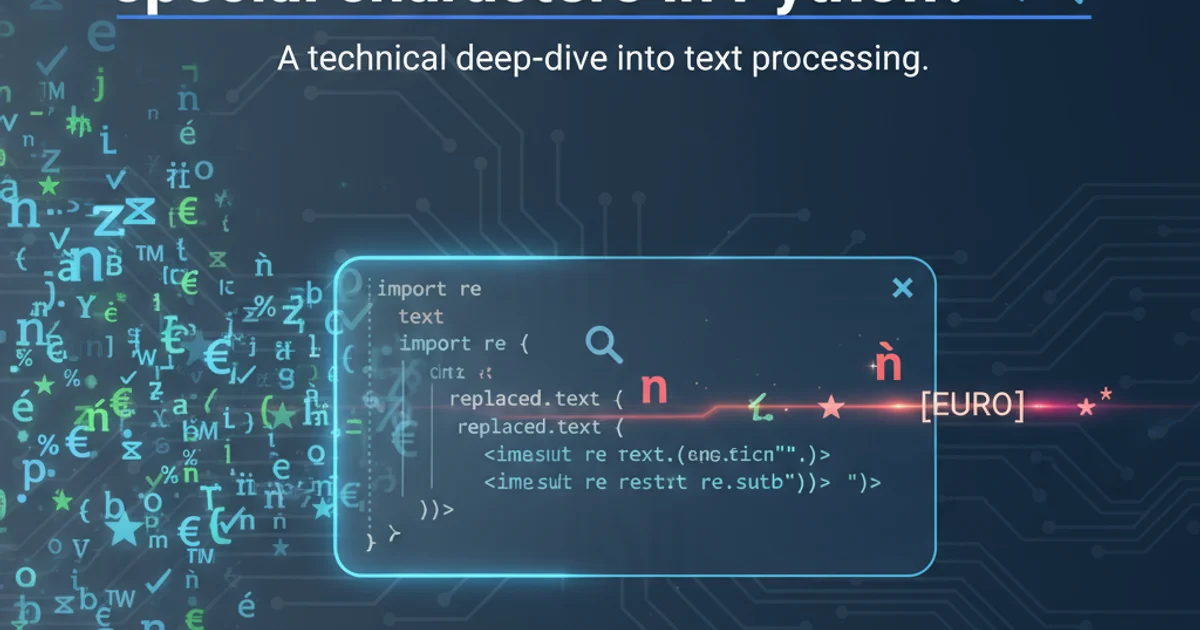How to search and replace utf-8 special characters in Python?
Categories:
Mastering UTF-8 Special Character Search and Replace in Python

Learn effective Python techniques for identifying and replacing a wide range of UTF-8 special characters, ensuring robust text processing.
Working with text data in Python often involves handling various character encodings, with UTF-8 being the most prevalent. Special characters, including accented letters, symbols, and non-ASCII characters, can pose challenges when you need to search for, replace, or normalize them. This article explores robust methods to effectively manage UTF-8 special characters in Python, ensuring your text processing is accurate and reliable.
Understanding UTF-8 and Special Characters
UTF-8 (Unicode Transformation Format - 8-bit) is a variable-width character encoding capable of encoding all 1,112,064 valid code points in Unicode. This means it can represent characters from virtually all writing systems, including Latin, Cyrillic, Arabic, Chinese, Japanese, and many more, along with a vast array of symbols and emojis. Special characters, in this context, refer to any characters that are not standard ASCII (0-127), such as é, ñ, €, ™, —, or even non-printable control characters. Python 3 handles strings as Unicode by default, simplifying many encoding issues, but specific techniques are still required for targeted search and replace operations.
flowchart TD
A[Input String (UTF-8)] --> B{Identify Special Characters?}
B -- Yes --> C[Normalization (Optional)]
C --> D[Define Replacement Strategy]
D --> E[Apply Regex or String Methods]
E --> F[Output String]
B -- No --> FWorkflow for searching and replacing UTF-8 special characters.
Method 1: Using str.replace() for Direct Replacements
For simple, one-to-one replacements of known special characters, Python's built-in str.replace() method is straightforward and efficient. This method is ideal when you have a specific set of characters you want to change to another specific character or string.
text = "Héllö Wörld! This is a test with € and ™ symbols."
# Replace specific characters
text_replaced = text.replace('é', 'e').replace('ö', 'o').replace('€', 'EUR')
print(text_replaced)
# Output: Hello World! This is a test with EUR and ™ symbols.
Direct replacement of specific UTF-8 characters using str.replace().
str.replace() is simple, it can become cumbersome for many replacements. Consider using a loop or a dictionary mapping for multiple replacements.Method 2: Regular Expressions (re module) for Pattern-Based Replacement
When dealing with a broader range of special characters, or when you need to replace characters based on a pattern (e.g., all non-alphanumeric characters, or all accented letters), the re module (regular expressions) is the most powerful tool. Python's re module fully supports Unicode, allowing you to define patterns that match various character categories.
import re
text = "Héllö Wörld! This is a test with € and ™ symbols, and some spaces."
# 1. Replace all non-ASCII characters with an empty string
# \x00-\x7F covers the ASCII range
text_no_non_ascii = re.sub(r'[^�-]+', '', text)
print(f"No non-ASCII: {text_no_non_ascii}")
# Output: No non-ASCII: Hll Wrld! This is a test with and symbols, and some spaces.
# 2. Replace all non-word characters (including spaces, symbols, but not underscores) with a single space
# \W matches any non-word character (equivalent to [^a-zA-Z0-9_])
text_word_chars = re.sub(r'\W+', ' ', text).strip()
print(f"Word chars only: {text_word_chars}")
# Output: Word chars only: Hll Wrld This is a test with and symbols and some spaces
# 3. Replace specific Unicode categories (e.g., all symbols) with a space
# \p{S} matches any symbol character (requires 're.UNICODE' flag or Python 3.6+)
text_no_symbols = re.sub(r'\p{S}', ' ', text, flags=re.UNICODE)
print(f"No symbols: {text_no_symbols}")
# Output: No symbols: Héllö Wörld! This is a test with and symbols, and some spaces.
Using re.sub() to replace UTF-8 special characters based on patterns.
re.UNICODE flag (or re.U) is crucial when using Unicode character properties like \p{L} (any letter), \p{N} (any number), \p{S} (any symbol), etc., in older Python versions. In Python 3.6+, this flag is often implied for \w, \b, \s, \d when working with Unicode strings, but explicit \p{} categories still benefit from it.Method 3: Normalization for Accented Characters
A common requirement is to convert accented characters (e.g., é, ü, ç) into their unaccented ASCII equivalents (e.g., e, u, c). Python's unicodedata module provides normalization forms that can decompose characters into their base character and diacritics, which can then be removed.
import unicodedata
import re
def remove_accents(input_str):
nfkd_form = unicodedata.normalize('NFKD', input_str)
# Filter out combining characters (diacritics)
# \p{Mn} matches 'Mark, Nonspacing' category
return re.sub(r'\p{Mn}', '', nfkd_form, flags=re.UNICODE)
text = "Héllö Wörld! This is a café with a résumé."
normalized_text = remove_accents(text)
print(normalized_text)
# Output: Hello World! This is a cafe with a resume.
Removing accented characters using unicodedata.normalize() and regular expressions.
\p{Mn} is effective. Be aware that some characters might not have a direct ASCII equivalent after normalization (e.g., € will remain € after this process).Choosing the Right Approach
The best method depends on your specific needs:
str.replace(): Use for a small, fixed set of known character replacements.re.sub()with character classes: Ideal for replacing entire categories of characters (e.g., all symbols, all non-alphanumeric) or complex patterns.unicodedata.normalize()+re.sub(): Perfect for converting accented characters to their unaccented ASCII equivalents.
1. Identify the problematic characters
Determine which specific special characters or categories of characters you need to search for and replace. This might involve inspecting your data or understanding the source of the characters.
2. Choose the appropriate Python method
Based on the identification, select str.replace(), re.sub(), or a combination with unicodedata.normalize().
3. Implement and test thoroughly
Write your Python code and test it with a diverse set of input strings, including edge cases, to ensure it handles all scenarios correctly.